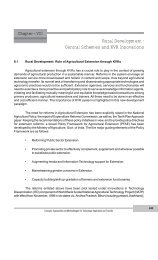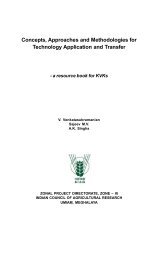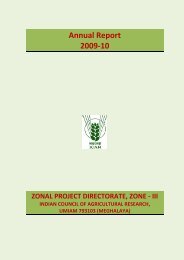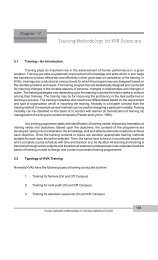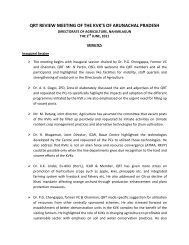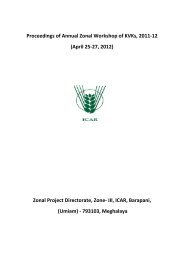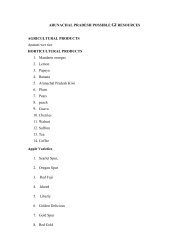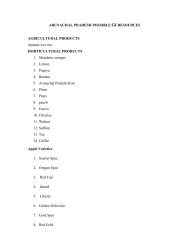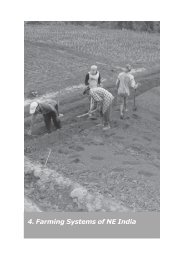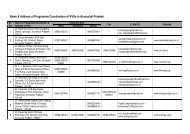Farming Systems Approach - ICAR, Zonal Project Directorate (Zone-III)
Farming Systems Approach - ICAR, Zonal Project Directorate (Zone-III)
Farming Systems Approach - ICAR, Zonal Project Directorate (Zone-III)
You also want an ePaper? Increase the reach of your titles
YUMPU automatically turns print PDFs into web optimized ePapers that Google loves.
Sajeev M.V, V. Venkatasubramanian & A.K. Singha<strong>Farming</strong> System Analysis: (FSA)<strong>Farming</strong> System Analysis (FSA) is an in-depth, quantitative analysis of an existing farming system ofthe study area. The farming system can be defined as “an unique and reasonably stable arrangementof farming enterprises that the household manages according to quell defined practices in response tophysical, biological and socio-economic environments and in accordance with the households’ goals,preferences and resources. These factors combine to influence the output and production methods.More commodities are found within the system than between systems. The farming system is part oflarger systems, i.e. the local community and can be divided into subsystems cropping systems. Centralto the system is the farmer himself (Shaner et al., 1982).Development of farming systems and reduction of hunger and povertyIn broad terms, there are five main farm household strategies to improve livelihoods. These can besummarized as:intensification of existing production patterns;diversification of production and processing;expanded farm or herd size;increased off-farm income, both agricultural and non-agricultural; anda complete exit from the agricultural sector within a particular farming system.These strategic options are not mutually exclusive, even at the individual household level; any particularhousehold will often pursue a mixed set of strategies.The first of these two strategies - intensification and diversification - form important components of theFAO Special Programme for Food Security (FAO 1999c). Intensification is defined in this book as increasedphysical or financial productivity of existing patterns of production; including food and cash crops,livestock and other productive activities. Although intensification is frequently associated with increasedyields as a result of greater use of external inputs, it may also arise from improved varieties andbreeds, utilization of unused resources, improved labour productivity, and better farm management -for example improved irrigation practices or better pest control.Diversification is defined as an adjustment to the farm enterprise pattern in order to increase farmincome, or to reduce income variability. It exploits new market opportunities or existing market niches.Diversification may take the form of completely new enterprises, or may simply involve the expansionof existing, high value, enterprises. The addition or expansion of enterprises refers not only to production,but also to on-farm processing and other farm-based, income generating activity.Some households escape poverty by expanding farm size - in this context size refers to managed ratherthan to owned resources. Beneficiaries of land reform are the most obvious examples of this source ofpoverty reduction. Increased farm size may also arise through incursion into previously non-agricultural10<strong>Farming</strong> <strong>Systems</strong> of North East India



